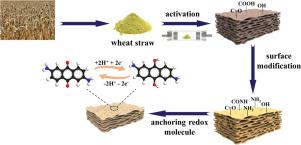Electrochimica Acta ( IF 5.5 ) Pub Date : 2022-11-13 , DOI: 10.1016/j.electacta.2022.141533 Yuanhai Bao , Hui Xu , Yuanqiang Zhu , Pengdong Chen , Yajuan Zhang , Yong Chen

|
The challenge of redox-active molecules for electrochemical capacitors is that they are easy to detach from the substrate during long-term charge-discharge cycles. In this work, redox-active molecule 2,6-diaminoanthraquinone (DAQ) is anchored on amino functionalized biomass porous carbon (FWS) via strong hydrogen bonding interaction. The protophilic C=O sites on the DAQ provide additional faradaic pseudocapacitance for biomass carbon-based electrode through fast redox reactions. In addition, the surface functionalization of porous carbon enhanced the interaction between the porous carbon and DAQ molecule, which inhibited the detachment of DAQ and significantly improved the electrochemical stability of the composite electrode. The optimized DAQ@FWS composite exhibits excellent specific capacitance of 424.9 F g−1 at 1 A g−1 with a stable capacity retention of 93.1% over 10,000 cycles at 10 A g−1, which is higher than unfunctionalized biomass porous carbon-based composite electrode (71.6% after 10,000 cycles). Meanwhile, DAQ@FWS composite maintains a high capacitance of 300.4 F g−1 even at 30 A g−1. Density functional theory calculations and detailed electrochemical analysis further elucidate the binding interactions of DAQ with FWS and charge storage mechanisms. Furthermore, coin-type symmetric supercapacitor based on DAQ@FWS exhibits excellent energy density (36.4 Wh kg−1 at 700.5 W kg−1), power density (7.001 kW kg−1 at 27.0 Wh kg−1) and durable cycling stability (capacitance retention is 88.3% after 10,000 cycles). Thus, amino functionalization of biomass porous carbon to anchor redox active organic quinones is promising as an effective strategy to fabricate superior performance supercapacitor electrode material.
中文翻译:

锚定在功能化生物质多孔碳上的 2,6-二氨基蒽醌提高了无金属氧化还原超级电容器电极的电化学稳定性
电化学电容器的氧化还原活性分子面临的挑战是它们在长期充放电循环期间很容易从基板上脱离。在这项工作中,氧化还原活性分子 2,6-二氨基蒽醌 (DAQ) 通过强氢键相互作用锚定在氨基官能化生物质多孔碳 (FWS) 上。DAQ 上的亲质 C=O 位点通过快速氧化还原反应为生物质碳基电极提供额外的法拉第赝电容。此外,多孔碳的表面功能化增强了多孔碳与DAQ分子之间的相互作用,抑制了DAQ的脱离,显着提高了复合电极的电化学稳定性。优化的 DAQ@FWS 复合材料表现出 424.9 F g -1的优异比电容在 1 A g -1下,在 10 A g -1下, 10,000 次循环的稳定容量保持率为 93.1% ,高于未功能化的生物质多孔碳基复合电极(10,000 次循环后为 71.6%)。同时,DAQ@FWS 复合材料即使在 30 A g -1下也能保持 300.4 F g -1的高电容。密度泛函理论计算和详细的电化学分析进一步阐明了 DAQ 与 FWS 的结合相互作用和电荷存储机制。此外,基于 DAQ@FWS 的硬币型对称超级电容器表现出优异的能量密度(36.4 Wh kg -1 at 700.5 W kg -1)、功率密度(7.001 kW kg -1 at 27.0 Wh kg -1) 和持久的循环稳定性(10,000 次循环后电容保持率为 88.3%)。因此,生物质多孔碳的氨基官能化以锚定氧化还原活性有机醌有望成为制造高性能超级电容器电极材料的有效策略。

































 京公网安备 11010802027423号
京公网安备 11010802027423号